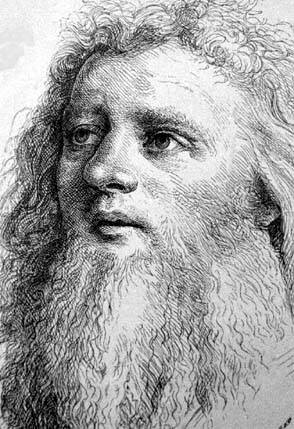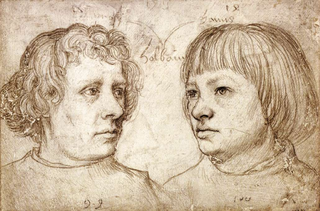
Hans Holbein the Elder was a German painter.

Ambrosius Holbein was a German and later a Swiss artist in painting, drawing, and printmaking. He was the elder brother, by about three years, of Hans Holbein the Younger, but he appears to have died in his mid-twenties, leaving behind only a small body of work.

Hans Holbein the Younger was a German-Swiss painter and printmaker who worked in a Northern Renaissance style, and is considered one of the greatest portraitists of the 16th century. He also produced religious art, satire, and Reformation propaganda, and he made a significant contribution to the history of book design. He is called "the Younger" to distinguish him from his father Hans Holbein the Elder, an accomplished painter of the Late Gothic school.

Lucas Cranach the Elder was a German Renaissance painter and printmaker in woodcut and engraving. He was court painter to the Electors of Saxony for most of his career, and is known for his portraits, both of German princes and those of the leaders of the Protestant Reformation, whose cause he embraced with enthusiasm. He was a close friend of Martin Luther. Cranach also painted religious subjects, first in the Catholic tradition, and later trying to find new ways of conveying Lutheran religious concerns in art. He continued throughout his career to paint nude subjects drawn from mythology and religion.

Renaissance art is the painting, sculpture, and decorative arts of the period of European history known as the Renaissance, which emerged as a distinct style in Italy in about AD 1400, in parallel with developments which occurred in philosophy, literature, music, science, and technology. Renaissance art took as its foundation the art of Classical antiquity, perceived as the noblest of ancient traditions, but transformed that tradition by absorbing recent developments in the art of Northern Europe and by applying contemporary scientific knowledge. Along with Renaissance humanist philosophy, it spread throughout Europe, affecting both artists and their patrons with the development of new techniques and new artistic sensibilities. For art historians, Renaissance art marks the transition of Europe from the medieval period to the Early Modern age.

Grisaille is a painting executed entirely in shades of grey or of another neutral greyish colour. It is particularly used in large decorative schemes in imitation of sculpture. Many grisailles include a slightly wider colour range.

The Alte Pinakothek is an art museum located in the Kunstareal area in Munich, Germany. It is one of the oldest galleries in the world and houses a significant collection of Old Master paintings. The name Alte (Old) Pinakothek refers to the time period covered by the collection—from the fourteenth to the eighteenth century. The Neue Pinakothek, re-built in 1981, covers nineteenth-century art, and Pinakothek der Moderne, opened in 2002, exhibits modern art. All three galleries are part of the Bavarian State Painting Collections, an organization of the Free state of Bavaria.

The German Renaissance, part of the Northern Renaissance, was a cultural and artistic movement that spread among German thinkers in the 15th and 16th centuries, which developed from the Italian Renaissance. Many areas of the arts and sciences were influenced, notably by the spread of Renaissance humanism to the various German states and principalities. There were many advances made in the fields of architecture, the arts, and the sciences. Germany produced two developments that were to dominate the 16th century all over Europe: printing and the Protestant Reformation.

Joseph Heintz the Elder was a Swiss painter, draftsman and architect.

The artists of the Tudor court are the painters and limners engaged by the monarchs of England's Tudor dynasty and their courtiers between 1485 and 1603, from the reign of Henry VII to the death of Elizabeth I.

The Body of the Dead Christ in the Tomb is an oil and tempera on limewood painting created by the German artist and printmaker Hans Holbein the Younger between 1520 and 1522.

Christ and the Woman Taken in Adultery is a small panel painting in grisaille by the Netherlandish Renaissance printmaker and painter Pieter Bruegel the Elder. It is signed and dated 1565.

Thoman Burgkmair, or Thomas Burgkmair was a German painter.

Peeter Baltens, Pieter Balten or Pieter Custodis, was a Flemish Renaissance painter, draughtsman, engraver and publisher. Baltens was also active as an art dealer and poet. He was known for his genre paintings, religious compositions and landscapes.
Ralph Nicholson Wornum (1812–1877) was a British artist, art historian and administrator. He was keeper and secretary of the National Gallery of London from 1855 until his death.
Fritz Grossmann, art historian. Born 26 June 1902 in Stanislau,, now Ivano-Frankivsk in the Ukraine, died 16 November 1984, Croydon, London) was an Austrian-British art historian.

The Nativity is a devotional mid-1450s oil-on-wood panel painting by the Early Netherlandish painter Petrus Christus. It shows a nativity scene with grisaille archways and trompe-l'œil sculptured reliefs. Christus was influenced by the first generation of Netherlandish artists, especially Jan van Eyck and Rogier van der Weyden, and the panel is characteristic of the simplicity and naturalism of art of that period. Placing archways as a framing device is a typical van der Weyden device, and here likely borrowed from that artist's Altar of Saint John and Miraflores Altarpiece. Yet Christus adapts these painterly motifs to a uniquely mid-15th century sensibility, and the unusually large panel – perhaps painted as a central altarpiece panel for a triptych – is nuanced and visually complex. It shows his usual harmonious composition and employment of one-point-perspective, especially evident in the geometric forms of the shed's roof, and his bold use of color. It is one of Christus's most important works. Max Friedländer definitely attributed the panel to Christus in 1930, concluding that "in scope and importance, [it] is superior to all other known creations of this master."

The Staatsgalerie Aschaffenburg is an art museum in Schloss Johannisburg in Aschaffenburg, Germany. With some 368 paintings, it is the largest of the galleries outside Munich making up the Bavarian State Painting Collections.

The Herrenberg Altarpiece is a winged altarpiece, that was created between 1518 and 1521 for the Brethren of the Common Life, a German Roman Catholic pietist community. It was built as a high altar for the collegiate church in Herrenberg in the state of Württemberg, now part of southwest Germany. Today the altarpiece, which has only survived in part, is in the possession of the Stuttgart State Gallery.

The Württembergischer Kunstverein Stuttgart was founded in 1827 and is one of the oldest art associations in Germany. The association, which today has around 3,000 members, is based in the Kunstgebäude Stuttgart and is dedicated to communicating contemporary art. The curator and publicist Martin Fritz has been the chairman of the Württembergischer Kunstverein, which belongs to the Arbeitsgemeinschaft Deutscher Kunstvereine (ADKV), since 2018.






























